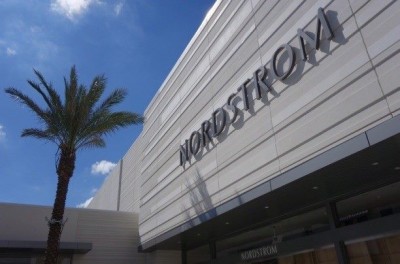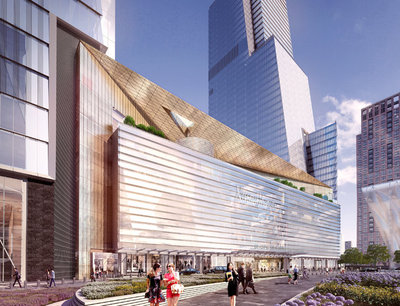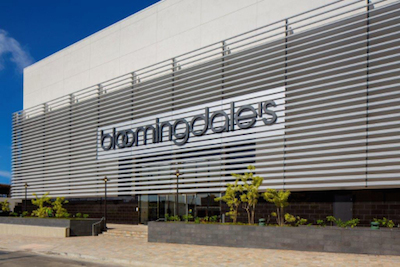 Photo of VivaLuxury courtesy of Bergdorf Goodman
Photo of VivaLuxury courtesy of Bergdorf Goodman
Department store chain Nordstrom is the top-rated luxury retailer, according to findings detailed in The Luxury Institute’s third annual Luxury Multi-Channel Engagement Index.
Consumers evaluated six luxury fashion retailers both in-store and online across a total of 31 attributes – 15 online and 16 in-store. Because the findings come from consumers, they can help each retailer determine which areas it needs to improve on and what specialties will help distinguish it from competitors.
“[We wanted] to get the voice of the client, not to have a panel of experts, not to have one individual,” said Milton Pedraza, CEO of The Luxury Institute. “This is the wealthy consumer rating their own experiences, these are all clients of the brands.”
Ahead of the pack
Barneys New York, Bergdorf Goodman, Bloomingdale’s, Neiman Marcus, Nordstrom and Saks Fifth Avenue were evaluated on the ease of 14 common criteria both online and in-store. In addition, there was one additional criterion for online shopping and two for in-store.
The common traits are: finding desired products, the perception consumers had of the retailer, product selection, customizability, customer service, policy on returns and exchanges, product displays, exclusive or limited products.
Traits also included whether selections were relevant to the consumer’s lifestyle, the availability of proper sizes, pricing, loyalty programs, confidence that the retailer would meet the consumer’s needs and how often products from that retailer receive compliments.
 Dior beauty counter at Saks Fifth Avenue
Respondents had a median age of 52, minimum household income of $150,000 and an average of $289,000 and $2.9 million in net worth, numbers that align with luxury retailers at large. Among the findings about consumers is that twice as much spending takes place in-store, with women and consumers under 45 years of age being more likely to spend online.
Bergdorf Goodman beat out Nordstrom in some notable categories. It is best perceived as a luxury retailer, as having the best prices and having the best personalized shopping experience.
However, Bergdorf Goodman has only two stores, one for men and the larger for women, both on Fifth Avenue in New York, whereas Nordstrom has 118, which will play into perceptions of luxury. Nevertheless, Bergdorf Goodman's relative aversion to discounting did not stop consumers from highlighting its prices.
Dior beauty counter at Saks Fifth Avenue
Respondents had a median age of 52, minimum household income of $150,000 and an average of $289,000 and $2.9 million in net worth, numbers that align with luxury retailers at large. Among the findings about consumers is that twice as much spending takes place in-store, with women and consumers under 45 years of age being more likely to spend online.
Bergdorf Goodman beat out Nordstrom in some notable categories. It is best perceived as a luxury retailer, as having the best prices and having the best personalized shopping experience.
However, Bergdorf Goodman has only two stores, one for men and the larger for women, both on Fifth Avenue in New York, whereas Nordstrom has 118, which will play into perceptions of luxury. Nevertheless, Bergdorf Goodman's relative aversion to discounting did not stop consumers from highlighting its prices.
 Nordstrom
Nordstrom topped the rankings of more categories than any other retailer. Among them: its convenient refund/return policy, carrying relevant products and styles, having a navigable Web site, including helpful ratings and reviews and good shipping policies online, convenient locations and in carrying products that are complimented by others. It also beat out national retailers in prices and having good personalized shopping.
Fittingly, Nordstrom is the most popular retailer online and leads in market-share on both channels.
Tough times
Mobile transactions do not comprise a large share of the revenue for any of the retailers. While mobile is an important part of the transaction journey for many consumers, who use it to research and in-store to compare prices and selection, it has not yet become a major source of transactions.
Retailers are missing out on significant revenue opportunities by failing to personalize consumers’ shopping experiences, thanks to the lack of adaptive pages, product recommendations and search functionalities on their mobile sites, according to a Retail Systems Research report.
In its “Personalization Across Digital Channels” report, sponsored by predictive analytics platform Reflektion, Retail Systems Research highlights the major faux paus that brands commit when it comes to mobile commerce. As consumers’ expectations for retailers’ digital offerings grow higher, marketers must deliver optimized experiences, including saved search histories, suggestions on previous purchases and responsive pages tailored to each device (see story).
Nordstrom
Nordstrom topped the rankings of more categories than any other retailer. Among them: its convenient refund/return policy, carrying relevant products and styles, having a navigable Web site, including helpful ratings and reviews and good shipping policies online, convenient locations and in carrying products that are complimented by others. It also beat out national retailers in prices and having good personalized shopping.
Fittingly, Nordstrom is the most popular retailer online and leads in market-share on both channels.
Tough times
Mobile transactions do not comprise a large share of the revenue for any of the retailers. While mobile is an important part of the transaction journey for many consumers, who use it to research and in-store to compare prices and selection, it has not yet become a major source of transactions.
Retailers are missing out on significant revenue opportunities by failing to personalize consumers’ shopping experiences, thanks to the lack of adaptive pages, product recommendations and search functionalities on their mobile sites, according to a Retail Systems Research report.
In its “Personalization Across Digital Channels” report, sponsored by predictive analytics platform Reflektion, Retail Systems Research highlights the major faux paus that brands commit when it comes to mobile commerce. As consumers’ expectations for retailers’ digital offerings grow higher, marketers must deliver optimized experiences, including saved search histories, suggestions on previous purchases and responsive pages tailored to each device (see story).
 Neiman Marcus Hudson Yards rendering
Nevertheless, online shares have grown and retailers have proven themselves adaptable to new technology.
“I think what [the data] tells you is that, even though we thought that the luxury multi brand chains were going to be overrun with the likes of Amazon and others, that just hasn't happened,” Mr. Pedraza said. “They have become very nimble and very agile at online and ecommerce. Don’t underestimate these omnichannel chains. They definitely will rise to the occasion.”
One of the major obstacles in both ecommerce and in being perceived as luxury is in discounting. Discounting is a surefire way to lure in new consumers short-term but represents longer-term risks for the brand.
As a result, many retailers have opened up discount stores, which, despite also risking perception, could become a venue to funnel discounted merchandise and leave the main store full-price.
Although this change could not be implemented suddenly without alienating some consumers, there are already signs that it is taking place and may become more visible as holiday shopping is amped up.
Neiman Marcus Hudson Yards rendering
Nevertheless, online shares have grown and retailers have proven themselves adaptable to new technology.
“I think what [the data] tells you is that, even though we thought that the luxury multi brand chains were going to be overrun with the likes of Amazon and others, that just hasn't happened,” Mr. Pedraza said. “They have become very nimble and very agile at online and ecommerce. Don’t underestimate these omnichannel chains. They definitely will rise to the occasion.”
One of the major obstacles in both ecommerce and in being perceived as luxury is in discounting. Discounting is a surefire way to lure in new consumers short-term but represents longer-term risks for the brand.
As a result, many retailers have opened up discount stores, which, despite also risking perception, could become a venue to funnel discounted merchandise and leave the main store full-price.
Although this change could not be implemented suddenly without alienating some consumers, there are already signs that it is taking place and may become more visible as holiday shopping is amped up.
 Bloomingdale's Ala Moana exterior
Consumers should expect a reduction in holiday promotions from retailers, according to a recent report by Upstream Commerce.
Based on the past two years of holiday promotions, the report predicts that 2015 will see a decrease in both the number of products discounted and in the discount rate. Fewer sales incentives and lower discounts could indicate a new strategy based on the “right” offering rather than simply presenting more promotions (see story).
"There is a lot of discounting out there, but full-price will remain relevant,” Mr. Pedraza said. “Unfortunately I suspect there will be a lot of discounting in the fourth quarter because when you enter their store they are flushed with inventory, all of them, so I think there’s going to be a big reduction.
“Traffic is down dramatically in all of these stores — some insider estimates, people on the inside of these companies, place traffic down anywhere from 20 to 30 percent,” he said. “It’s going to be a very tough fourth quarter, at least on market.
“We may see the top line improvement because of the discounting and you’re going to sell more, but we may see that the margins erode and by the way we may see comps that are not that good. Luxury right is in a very tough place, nowhere near what it was in 2008, everybody is suffering.”
Final Take
Forrest Cardamenis, editorial assistant on Luxury Daily, New York
Bloomingdale's Ala Moana exterior
Consumers should expect a reduction in holiday promotions from retailers, according to a recent report by Upstream Commerce.
Based on the past two years of holiday promotions, the report predicts that 2015 will see a decrease in both the number of products discounted and in the discount rate. Fewer sales incentives and lower discounts could indicate a new strategy based on the “right” offering rather than simply presenting more promotions (see story).
"There is a lot of discounting out there, but full-price will remain relevant,” Mr. Pedraza said. “Unfortunately I suspect there will be a lot of discounting in the fourth quarter because when you enter their store they are flushed with inventory, all of them, so I think there’s going to be a big reduction.
“Traffic is down dramatically in all of these stores — some insider estimates, people on the inside of these companies, place traffic down anywhere from 20 to 30 percent,” he said. “It’s going to be a very tough fourth quarter, at least on market.
“We may see the top line improvement because of the discounting and you’re going to sell more, but we may see that the margins erode and by the way we may see comps that are not that good. Luxury right is in a very tough place, nowhere near what it was in 2008, everybody is suffering.”
Final Take
Forrest Cardamenis, editorial assistant on Luxury Daily, New York
